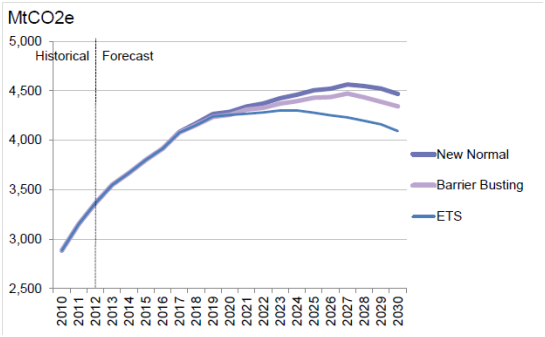Wind & solar outpace coal in China by 2030 - Bloomberg
Bloomberg New Energy Finance (BNEF) has released analysis which finds renewables will make up more than half of new power capacity growth in China to 2030, across a variety of plausible scenarios. By 2030 total installed capacity of renewable energy power plants will equal that of coal.
This study sought to examine how technological and economic changes might realistically alter the make-up and growth of China’s power sector. They found that coal’s dominance will be challenged by:
– faster technological improvement and cost reductions achieved by renewable energy technologies;
– increased social concern and, consequently, government regulation over environmental pollution;
– the prospects of shale gas, and;
– a potential price on carbon emissions.
The chart below illustrates BNEF’s outlook for power capacity additions under the four scenarios it examined, of which the New Normal scenario is considered their most likely. According to BNEF, the key reasons underlying the rapid growth of renewable energy are i) the continuously improving economics of wind and solar PV due to falling technology costs, ii) increasing costs for coal-fired plants as a result of environmental controls, and iii) the expected uptake of distributed solar PV in China's commercial sector.
Power generation capacity additions under different scenarios, 2013-2030
(Gigawatts)

Source: Bloomberg New Energy Finance. Note: Pumped hydro excluded.
Now while renewables in combination with nuclear completely dominate new capacity additions, coal’s power generation capacity still grows in absolute terms. Coal remains the largest source of power generation, however its share of energy generation declines from 72 per cent in 2012 to 58 per cent in 2030 in the New Normal scenario. Also, because of renewables’ lower capacity factors (the amount of energy produced per unit of capacity installed), its share of power generation rises from 21 per cent in 2012 to 29 per cent in 2030 in spite of dominating new installations.
BNEF also examine likely developments in carbon emissions from the power sector. Under all scenarios China’s emissions begin to decline prior to 2030. If a carbon price is placed on China's power sector, as has been foreshadowed by government officials within the National Reform and Development Commission, emissions will peak as soon as 2023. This is at a relatively low averaged carbon price of 99 yuan, or $US16, per tonne of CO2 across 2017-30.
Annual carbon emissions from China’s power sector

Source: Bloomberg New Energy Finance. Note: a carbon price is also implemented under the Barrier Busting scenario at a lower level than the ETS scenario.
It’s worth noting that stabilisation and decline of emissions around the 2020-25 period is quite impressive given that BNEF also forecasts that China’s power market will double between now and 2030. China is still going through a process of urban industrialisation as it brings its population out of rural poverty – something the western world overcame in the early 20th century.
The implications of this transformation in the Chinese power sector will extend well beyond China. The rest of the world will benefit from the vastly greater economies of scale China will provide in wind turbines, solar PV, solar thermal and nuclear. So China will effectively help the rest of the world decarbonise.
Indeed, China has already demonstrated what’s in store by reducing the cost of solar PV modules so much that they are now commonplace on roofs across the mortgage belt suburbs of Australia. Between one-in-10 and even as much as one-in-three households now have solar PV systems installed in the outer metropolitan suburbs of Sydney, Brisbane, Perth, Adelaide and Melbourne as well as several regional cities. Such an outcome wasn’t even dreamt about by the most wildly optimistic greenie just four years ago.
What Japan did for consumer electronics, China will do for clean energy.
















